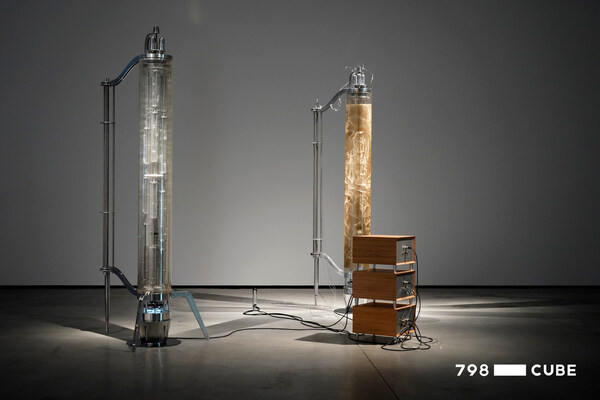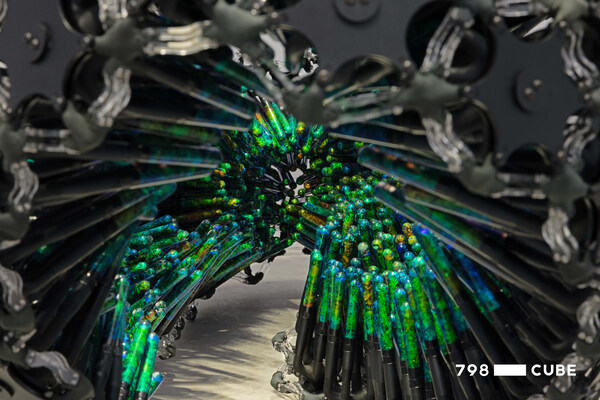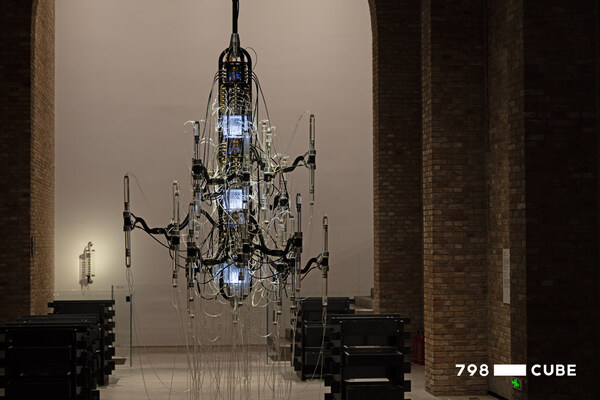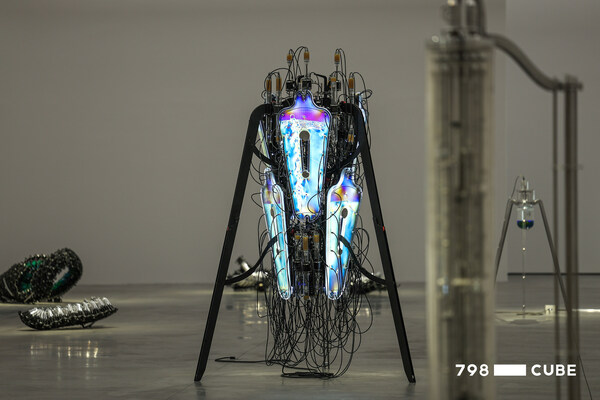BEIJING, July 19, 2024 /PRNewswire/ -- The convergence of art and science can ignite thrilling innovations. Internationally renowned artist Yunchul Kim has crafted a universe of transmattering at 798CUBE, fostering the synergy of creative technology and forward-looking artistic production. His exhibition, Elliptical Dipole: Visceral Particles and Sorcerous Flows, marks both his debut solo showcase in China and his most extensive presentation to date.

Yunchul Kim, Installation views of CHROMA IX (front) and Argos-the Swollen Suns (back), Elliptical Dipole: Visceral Particles and Sorcerous Flows, 798CUBE, Beijing, 2024.
The exhibition features Kim's most iconic pieces from various phases of his career, alongside his latest experimental works. Visitors are invited to immerse themselves in the artist's visionary matterReality (a term coined by Yunchul Kim) and resonate with the cosmic infinity, unraveling the perpetual enigma of polarity within the captivating vista of "Elliptical Dipole."
Encapsulating Yunchul Kim's intellectual pursuit and artistic insight, ZHANG Ga, curator of the exhibition, has noted the following:
Yunchul Kim is an alchemist turned physi-chemical provocateur. He seems to bear the brunt of modernity's quintessence. As an artist with a philosophical penchant for the most current, reminiscent of what Arthur Danto radically illuminated about art today, he is both old-school and ultra-modern, befitting what Giorgio Agamben has argued: "Contemporariness inscribes itself in the present by making it above all archaic." He employs concepts such as pataphysics and transmattering in his thought process before getting entrenched or enchanted, one might say, in his intricate laboratory work with rocks and metals, recently also biological agents, churning them into micro-substances and unspeakable elements that can only be extrapolated in particle physics and electro-magnetic fluids that have dipolar charges to fire up otherworldly sensations and spiritual meditations.
Yunchul Kim thinks cosmologically and acts microphysically. He allows himself to indulge in cosmic reveries, meandering through the geophysical expanse and astrophysical immensity and permitting caprice in planetary temporality alongside the circadian cycle of earth-bound creatures. He is at once pre-scientifically abstruse, recalling when alchemistic enunciation proclaimed the divinity of a totality of the living and the undead, of solids and spirits, and in which the suprarational reigned in the domain of knowledge, and post-humanistically amorphous, by which homo sapiens is understood microbially in rapport with plants, and quantum mechanically in tandem with rocks and stones (we are all particles!).
Argos (2022), our first encounter with Kim's preternatural reality, is reminiscent of the monolith in Space Odyssey that channels the celestial stupendous to the everyday profane by the violent act of cosmic rays striking the earth's atmosphere. In this ultimate contact of the human abode with the cosmos, the thousand-eyed monumental structure originating in Greek antiquity, equipped with a modern apparatus of a Geiger Muller tube, scans muons, the subatomic particle that is the result of the interstellar collision, transforming into sounds and lights and setting in motion cluster of actions and interactions of things and substances in their vicinity - it crisscrosses, traversing matters of different natures, magnitude and properties, materializing not only matters of fact but also "matters of concern," as Bruno Latour would have it, enabling a reciprocity that is both physi-chemically necessary and ethical-aesthetically indispensable.
The French philosopher of science Gaston Bachelard once stated that "realization takes precedence over reality," that is, in Yunchul Kim's parlance, a techno-matteReality which foregoes the real perceived by human sensory faculties. Chroma IX (2024), the colossal, knotted assemblage of a vastly elongated ouroboros form, engenders a reality coming into being through the very process of putting into action the phenomenon of fluctuation of the variegated liquid that is the marvelous work of a modern alchemist, of an entanglement of energies both positive and negative, converging into an elliptic dipole in sedimentation and ascension. Yunchul Kim hence presents to us a reality through the actualization of a techno-phenomenological phenomenon: phenomenon that is instrumentally produced and has "no genetic tie to human consciousness and perception." (Mark Hansen, The Critique of Data) In doing so, the artist has intuitively undone the damage of anthropocentric hubris and made equal footing of varied and multitudinous subjectivities.
We get a glimpse into Yunchul Kim's underworld of alchemy.
Amorph II (2024) reveals, shedding light on the intricate contrivance and technicality Yunchul Kim creates in his visual enchantment. Rather than an optical illusion, the wondrous spectrum and brilliant intensity are a manifestation of a materiality of forces, both artificial and organic, solidified in the form of hydrogel derived from layers of seaweeds. Ancient tapestry techniques and the progressive mono-tonality of Morton Feldman weave into the transcendental splendor of the artist's imaginative mattereality. Two installations of Amorph II, resonating with each other across the expansive gallery space, in Yunchul Kim's pataphysical explication, make salient a "matterphor" in the physicality of an ellipse enacted by dipoles. It is eternity reconciled with evanescence, like in the quantum mechanical revelation of waves and particles, commingling, erupting, penetrating the Double Slit to land both infinitely far and near all at once. In that vertigo of electromagnetic charges, opposite forces achieve an equilibrium and arrive at the negentropic tranquility.

Yunchul Kim, Installation view of Triaxial Pillars II, "Elliptical Dipole: Visceral Particles and Sorcerous Flows”, 798CUBE, Beijing, 2024.
If Zielinski's polyphonic articulation on Variantology stems from his erudite study of Deep Time through the lens of media archeology, Yunchul Kim, once a student of the prolific professor, inherits not only his mentor's pluralist worldview of humans ancient and modern, but also takes the word very literally in the mineralogical sense of stratification of rocks in light of geological immensity and with the cellulose composition of trees that enliven, and of that which subsists at the bottom of the deep ocean. In Strata (2024), the artist explores material verity that is beyond immediate human perception and cultural conception, excavating and unveiling the depth of pigmentation unseen by a naked eye.

Yunchul Kim, Installation view of Strata, "Elliptical Dipole: Visceral Particles and Sorcerous Flows”, 798CUBE, Beijing, 2024.
If Studio Locus Solus is the hermitage where Yunchul Kim and his assistants exercise their arcana of metal, stone and vegetation, Remnant Vitrine (2024) opens a window unto the sorcerous inside. Nested in an alcove in the mezzanine area, the Remnant Vitrine is a miniature laboratory that hosts a medley of the alchemist's archive of things, objects not following the convention of classification, but alongside the exactitude of materiality such as measurements beyond the apparently visible or matter's indeterminacy contingent on temperature, pressure, and the elasticity that's yet to be unleashed from the potentiality of the thing itself. The juxtaposition and infiltration of varied categories defy the taxonomy of species, genus, family, order, class, phylum, kingdom, domain, etc. The chandelier of magic (Impulse) hanging above appears as a crystallization of wondrous and uncanny things, its hydraulically powered pumps resemble the respiratory connectedness of a living tree, pulsating and resonating, circulating liveliness throughout in an audio-visual spectacle both sublime and subliminal.

Yunchul Kim, Installation view of Impulse, "Elliptical Dipole: Visceral Particles and Sorcerous Flows”, 798CUBE, Beijing, 2024.
As much a visual artist as an accomplished musician, Yunchul Kim constructs his own devices to make music that is electronically acoustic and classically avant-garde. His turntable-styled instrument C-Ray is a chemical reactor turned synthesizer which amplifies the seawater-generated electrical currents into audio signals. Sound is produced by a chemically infused "writing pencil," inscribing onto an aluminum plate. It is a material imprint that materializes the inaudible.
Yunchul Kim eschews the convenience of a metaphorical toolkit, defies the dictatorial sovereign of the Signifier. His pataphysical imperative demands a "matterphor" that is capable of agential autopoiesis, that impregnates and brings forth. His world is otherworldly in which only surrationalism can untie the never-ending knot of polarity in the mesmerizing image of Elliptical Dipole. The artist's mystic granules thus stir up emotive flux in the concurrence of cosmology and mineralogy, of biology and geology; of monad and dialectics, of immanence and contradiction; and ultimately, of life and death in the co-rising of the ascending flare of eternal return, in the atomic vortex that swallows humans and everything else, Yunchul Kim finds his own respite and solace.
The earthly space is a space where you can see the hydrodynamic flow of nanoparticles made from stones, seaweed, and trees. For example in the artwork La Poussière de Soleils II (Dust of Suns II) , Kim created a new substance composed of mineral particles that boiled and spewed in a hexagonal glass container, achieving the simultaneous awakening and sublimation of organic and artificial objects. And for his new creation Strata, explores physical realities that beyond human perception and cultural concepts, unearthed and revealed the depth of colors invisible to the naked eye.

Yunchul Kim, Installation view of La Poussière de Soleils II (Dust of Suns II), "Elliptical Dipole: Visceral Particles and Sorcerous Flows”, 798CUBE, Beijing, 2024.
Yunchul Kim is an artist and electroacoustic music composer. Asking fundamental questions about "material" and "materiality", he has demonstrated the possibilities of imagination and the creation of a reality beyond the realm of human experience, paying attention to its potential tendencies. His work embodies the material world imagined by the artist and is a story of a dimension before humans formed cultures or were defined by language. His works, in which humans, non-humans, machines, materials, and substances are considered equal, exist as active matter (transmattering) as the subject of events.
He has won international awards, including the 2016 Collide International Award from CERN, Ars Electronica, and the VIDA 15.0 Third Prize. His works have been presented by a number of prestigious international organizations, including the Korean Pavilion, 59th La Biennale di Venezia, Italy; CCCB, Spain; FACT Liverpool, UK; Ars Electronica, Austria; Frankfurter Knstverein, Germany; and International Triennial New Media Art Exhibition, China. He was chief researcher of the research group Mattereality at the Transdisciplinary Research Program at the Korea Institute for Advanced Study. He is a member of the art and science project group Fluid Skies and Liquid Things, an artistic research project at the University of Applied Arts, Vienna, Austria.
About the Curator:
Zhang Ga is a media art curator. He was curator of three editions of Media Art Triennial (National Art Museum of China, 2008-2014). His recent curatorial projects include Chaosmosis: A WANG Yuyang Exhibition (Shenzhen Art Museum, 2024), Motion Is Action: 35 Years of Chinese Media Art (By Art Matters, 2023), Topologies of the Real (MoCAUP, 2023), The 6th Guangzhou Triennial (co-curator, GDMOA, 2018), and Datumsoria: The Return of the Real (ZKM, 2017). His publications include edited books and essays. He is currently Distinguished Professor at Central Academy of Fine Arts. Since 2015, he directs Chronus Art Center in Shanghai.
About 798CUBE:
798CUBE is located in the core area of 798 Art District in Beijing, with a floor area of 3600 square meters, the building is designed by renowned Chinese contemporary architect and artist Zhu Pei, and is one of a series of experimental creations by Studio Zhu Pei on the theme of industrial heritage. The industrial "box cluster" in 798 Art District fully demonstrates the combination of technology, art and industrial heritage. With the slogan "Into the Unknown", 798CUBE is dedicated to the integration of science and technology and art. Relying on the innate advantage of 798 Art District as China's cultural card for contemporary art, 798CUBE creates a platform for the general public to link international high-quality art resources, to inspire the public in the context of emerging science and technology and the avant-garde art breeding, and participating in the world-wide art context.
Curated by: Zhang Ga
Presented by: Beijing 798 Culture and Technology Co., Ltd.
Organized by: 798CUBE
Duration: 2024.05.25-2024.10.13
Address: 798CUBE, 798 Art District Creative Square, Chaoyang District, Beijing
CONTACT: Una Ding, [email protected]

